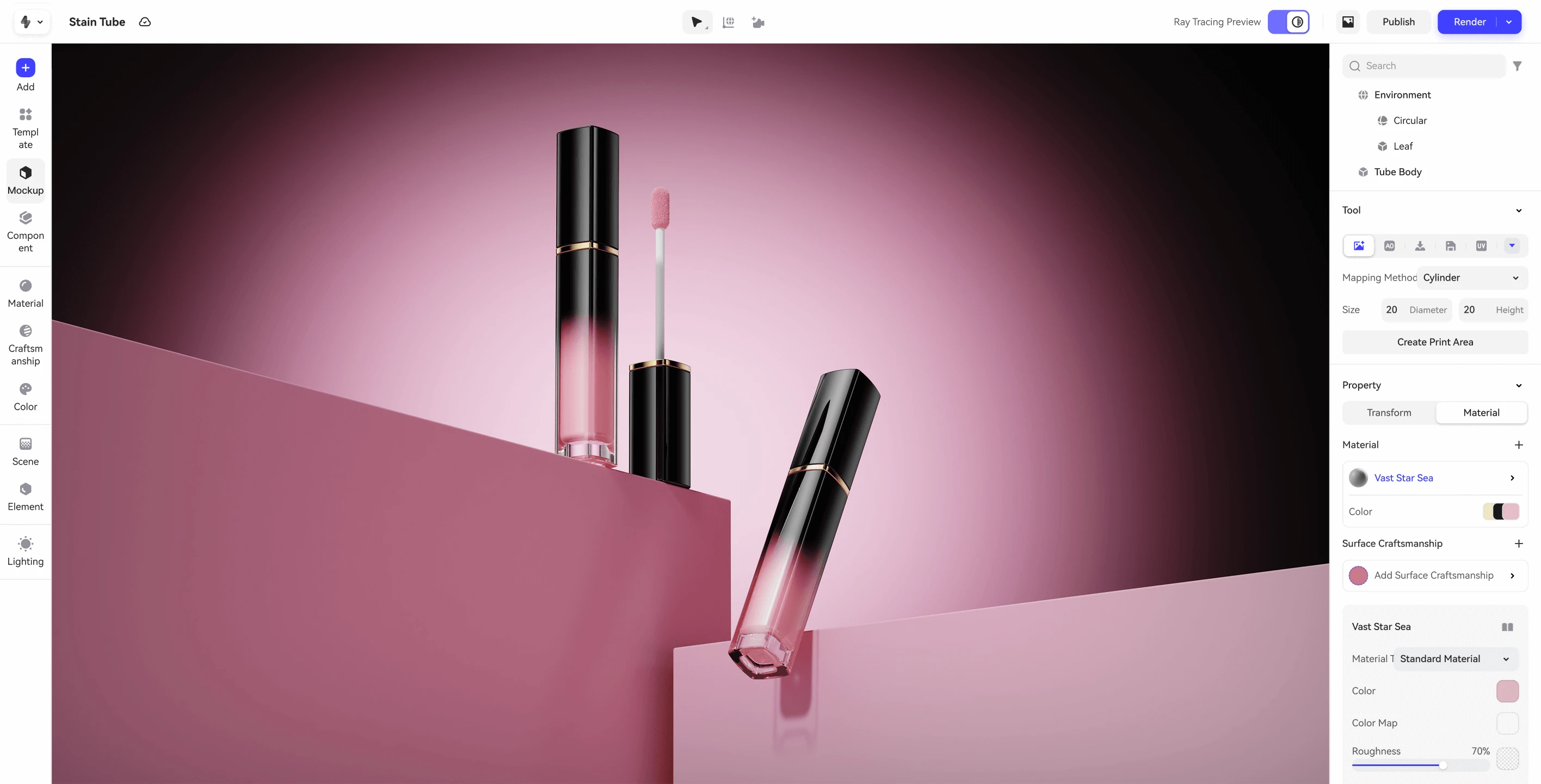I remember the exact moment KeyShot first blew my mind. It was years ago, I was wrestling with a needlessly complex V-Ray scene for a simple product shot, my office echoing with the desperate whir of my workstation's fans. A colleague walked over, clearly amused by my struggle, and said, "You have to see this."
He opened KeyShot. He dragged in the model, dropped on a plastic material from the library, selected a basic lighting environment, and in less than thirty seconds, had a render that was 90% better than what I’d spent the last three hours building. It didn’t feel like software. It felt like magic.
For years, KeyShot earned its crown as the undisputed king of speed and ease of use in the rendering world. It democratized photorealism for thousands of designers and engineers. But in 2025, the game has changed. The central challenge for creative teams is no longer just making a beautiful image. It’s about managing the entire creative workflow around it.
So, the big question is: did the world move on while the king was still on the throne? Let's take an honest look.
The Short Version: A 60-Second KeyShot Review
For those on a deadline, here’s the bottom line.
A Quick Verdict: KeyShot is a world-class digital photo studio in a box. For a solo designer or a small, co-located team that needs to create stunning product visuals with minimal fuss and technical overhead, it remains one of the best, most intuitive tools on the planet.
You'll Love It For:
 Its breathtakingly fast real-time viewport.
Its breathtakingly fast real-time viewport. The legendary simplicity of its drag-and-drop workflow.
The legendary simplicity of its drag-and-drop workflow. The sheer quality of its scientifically accurate materials and lighting environments.
The sheer quality of its scientifically accurate materials and lighting environments.
You Might Struggle With:
 Its fundamentally isolated, desktop-bound workflow.
Its fundamentally isolated, desktop-bound workflow. A clunky, file-based collaboration process that feels dated.
A clunky, file-based collaboration process that feels dated. A professional price tag that represents a significant investment.
A professional price tag that represents a significant investment.
The Modern Alternative: For creative teams who love KeyShot's speed but need a modern, web-native workflow, a platform like Realishot is purpose-built to solve these exact collaboration and accessibility challenges.
What KeyShot Does Brilliantly (And Why It Became an Industry Standard)
To critique a king, you must first acknowledge why it wears the crown. KeyShot didn't just join the market; it created a new one by focusing on three revolutionary principles.
The Magic of the Real-Time Viewport
-5al51z.jpeg) The famously intuitive drag-and-drop interface of KeyShot showing a product render
The famously intuitive drag-and-drop interface of KeyShot showing a product render
Before KeyShot, rendering was a "set it and forget it" process. You’d send your scene into the void and pray that in three hours, the result would be what you imagined. KeyShot’s real-time viewport changed everything. It transformed rendering from a guess into a conversation. What you see is what you get, instantly. The ability to tweak a material's roughness and see the highlight change in real-time is a creative feedback loop that is still, to this day, an absolute joy to work with.
Simplicity as a Philosophy
KeyShot made a bold bet: that a powerful tool didn’t have to be complicated. It stripped away the intimidating menus, the complex shader networks, and the arcane settings that plague other renderers. It showed the world that creating a photorealistic image could be as simple as:
 Importing your model.
Importing your model. Dragging a material onto it.
Dragging a material onto it. Choosing a lighting environment.
Choosing a lighting environment. Picking a camera angle.
Picking a camera angle.
This intuitive approach opened up high-end rendering to a generation of product designers, engineers, and marketers who didn't have the time or patience to become 3D technical artists. This focus on usability has earned it a top spot in our list of the Easiest 3D Rendering Software for years.
A Library of Scientific Truth
The “secret sauce” behind KeyShot’s realism is its commitment to physical accuracy. Its vast library isn't just a collection of pretty materials; it's a database of scientific properties. The "Glossy Plastic" isn't just a look; it's a simulation of how light interacts with that specific polymer. The HDRI environments aren't just background images; they are captured spheres of real-world light. This foundation in science is what allows users to achieve stunning realism with so little effort.
Where the Crown Slips: The Workflow Challenges of 2025
KeyShot perfected the art of creating a beautiful image inside a self-contained world. But the way we work has changed, and this is where the walls of its gilded cage start to show.
The Gilded Cage: Trapped on the Desktop
The biggest challenge with KeyShot today isn't about its features; it's about its philosophy. It is a product of the desktop era. For a solo artist, this is fine. For a modern, collaborative team, it's a significant bottleneck.
Here's the painful, real-world "KeyShot workflow" for getting feedback:
 Finish your render setup and save a massive .ksp file (often hundreds of megabytes).
Finish your render setup and save a massive .ksp file (often hundreds of megabytes). Upload this file to Dropbox, Google Drive, or WeTransfer.
Upload this file to Dropbox, Google Drive, or WeTransfer. Send a link to your creative director or client via email or Slack.
Send a link to your creative director or client via email or Slack. Wait for them to download the file (assuming they even have KeyShot installed and licensed).
Wait for them to download the file (assuming they even have KeyShot installed and licensed). Receive feedback in the form of an easily misinterpreted email ("maybe a bit more to the left?") or, worse, a screenshot with crude drawings on it.
Receive feedback in the form of an easily misinterpreted email ("maybe a bit more to the left?") or, worse, a screenshot with crude drawings on it. Go back to Step 1.
Go back to Step 1.
This process is slow, clunky, and ripe for version control errors. It feels utterly archaic compared to the fluid, web-based tools we use in every other aspect of our work. For artists working on a Mac-based workflow, this file-sharing juggle can be especially frustrating.
The Price of Specialization
KeyShot is expensive, and for that price, it does one thing: it renders. It’s not a modeler. It's not a texturing suite. It’s a specialized tool that relies entirely on other software to feed it. This isn't necessarily a bad thing—specialization leads to excellence—but it means the total cost of your creative pipeline is much higher than the KeyShot price tag alone.
The Evolution: A Modern Alternative with a Cloud-Native Brain
This brings us to the evolution. What if you could take the core ethos of KeyShot—speed, quality, and ease of use—and rebuild it for the way modern teams actually work? The answer to that question looks a lot like Realishot.
But the crucial question remains: can a browser-based tool truly match the raw output quality of a dedicated desktop powerhouse like KeyShot? The answer is an emphatic yes. The goal of a platform like Realishot isn't to be a "good enough" web alternative; it's to deliver the same best-in-class visual fidelity while revolutionizing the workflow.
 A side-by-side comparison showing the photorealistic rendering quality of Realishot versus KeyShot
A side-by-side comparison showing the photorealistic rendering quality of Realishot versus KeyShot
Solution: From a Desktop Silo to a Collaborative Studio
This is the fundamental difference. Instead of the clumsy, multi-step process described above, the Realishot workflow is brutally efficient:
 Work on your scene in the browser.
Work on your scene in the browser. Copy a single, secure web link.
Copy a single, secure web link. Send it to your client or team.
Send it to your client or team.
They can open that link on any device (computer, tablet, even their phone), orbit the model in full 3D, and leave annotated feedback directly on the product. The communication gap is closed. The version control nightmare is over. The entire friction-filled feedback loop dissolves, a problem that plagues even the best free 3D rendering software.
Solution: AI as the New "Drag-and-Drop"
Realishot takes KeyShot's simplicity a step further. Its AI-assisted setup acts like a virtual art director, analyzing your model and automatically applying a beautiful, plausible lighting and shadow setup. This gives you a professional-grade starting point in seconds, allowing you to focus on creative refinement, not tedious technical configuration. The result is professional-grade imagery, perfect for modern e-commerce and marketing campaigns, created with a fraction of the traditional effort.
 Professional cosmetic packaging render created in Realishot, showcasing its material and lighting capabilities
Professional cosmetic packaging render created in Realishot, showcasing its material and lighting capabilities
Solution: Accessible Power, Not Just Expensive Power
KeyShot is a premium product with a premium price tag. Realishot operates on a more accessible SaaS model. A powerful free tier allows anyone to start creating immediately, and the professional subscription costs a fraction of a traditional desktop license. This democratizes access to professional-grade tools for freelancers, startups, and growing teams.
At a Glance: KeyShot vs. Realishot Head-to-Head
| Feature | Luxion KeyShot | Realishot |
|---|---|---|
| Workflow Type | Desktop-Bound Silo | Cloud-Native & Collaborative |
| Collaboration | Manual, File-Based (Email, Dropbox) | Excellent (Live Link Sharing & In-App Feedback) |
| Ease of Use | Excellent (Drag-and-Drop) | Excellent (AI-Assisted & Templated) |
| Render Quality | Excellent (Ray Traking) | Excellent (Ray Traking) |
| Best For... | Solo Designers, Engineers | Modern, Agile, & Distributed Teams |
| Pricing Model | High Upfront Cost (Perpetual/Sub) | Accessible (Freemium/SaaS) |
Conclusion: Is KeyShot Still a Buy in 2025?
So, is KeyShot still a king? The answer is a nuanced one.
For the solo industrial designer working in a secure, offline environment, with the budget to afford it and a workflow that doesn't demand constant collaboration, KeyShot remains a magnificent, best-in-class tool. It is a superb instrument for a very specific type of artist.
However, for the vast majority of modern marketing departments, design agencies, and freelance teams, the creative world has moved on. The challenge is no longer just about creating a single beautiful image. It's about the speed, agility, and collaborative efficiency of the entire creative process. The paradigm has shifted.
And in this new paradigm, a cloud-native platform like Realishot doesn't just offer an alternative; it offers a profound advantage. It delivers the stunning quality and ease of use that made us fall in love with KeyShot, but in a package built for the hyper-connected, fast-moving, and collaborative reality of work in 2025. It solves the workflow, and in doing so, it wins the future.
